

Originally posted July 8, 2017
The other day I was out and about, and I found myself browsing around a gun shop I don't often get to. They had a rack of lever-action rifles, so I snouted around it out of curiosity, thinking I might get my own Winchester '94 one of these days. At the end of the rack I was mildly surprised to run across one of that venerable product's competitors, which, though it was plenty popular in its own right, you don't tend to see much around here, for whatever reason.
Meet the Savage Model 1899:

We've heard of Savage before, albeit only as the company that acquired J. Stevens Arms and Tool in 1920. It's one of the old names in American firearms, although it's been attached to any number of different companies, even back in the Elder Days. According to George Markham's Guns of the Wild West, one Edward Savage was making percussion revolvers as early as 1856, under his own name and as part of a partnership called Savage & North.¹ By the 1890s, the principal of the various companies doing business under that name was Arthur Savage, who I assume was Edward's descendant.
A bit like Samuel Colt, Arthur Savage seems to have had a hard time keeping the companies bearing his name alive for more than a few years at first. As an individual inventor, he submitted a lever-action rifle for the military trials in 1892 (which would ultimately result in the adoption of the Krag-Jørgensen); three years later, under the name "Savage Repeating Arms Company", he licensed a sporter version of that rifle for production by the Marlin company; four years after that it was a different Savage Arms Company (I guess by 1899, "Repeating" seemed a bit redundant) that brought a refined version of the 1895 rifle to market independently.
Having been conceived in part to compete with Winchester's Models 1886, 1892, and 1894, the Savage '99 had to be designed not to infringe any of John Moses Browning's many, many patents while accomplishing basically the same thing. A lot of firearms have origin stories like that, of course; there is, for instance, the huge slew of repeating handguns from the 1850s and '60s that had to work around Smith & Wesson's preposterous Rollin White patent (about which we will hear more in a later post). A lot of the time, though, those workarounds are not particularly good; their only real virtue is that they're legal.
Happily, the Savage '99 is not one of those. It accomplishes the goal of doing the same thing as the Winchester '94 in a different way, and does it with an elegance that is often missing from guns specifically created to compete with patented masterpieces like the '94. Let's have a closer look.
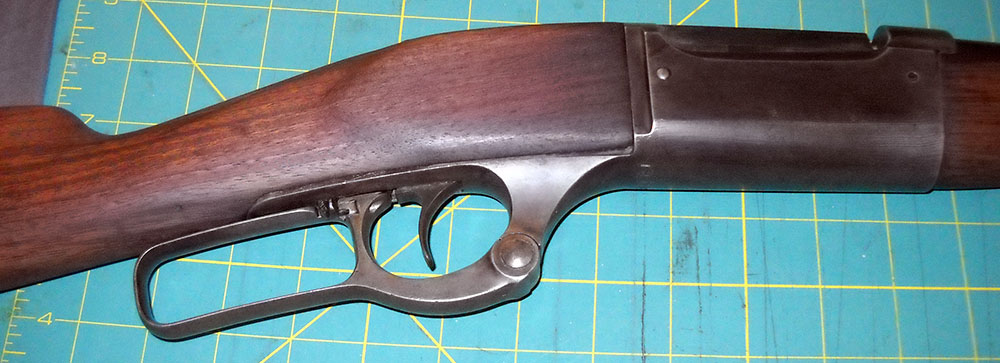
The first obvious thing to notice about the Savage '99's action is that the lever has that big hinge in it. The forward bit is a fixed part of the receiver's lower tang. This is in marked contrast to the Winchester's, which has to be hinged at the very front because the front end of the lever is where the action happens:
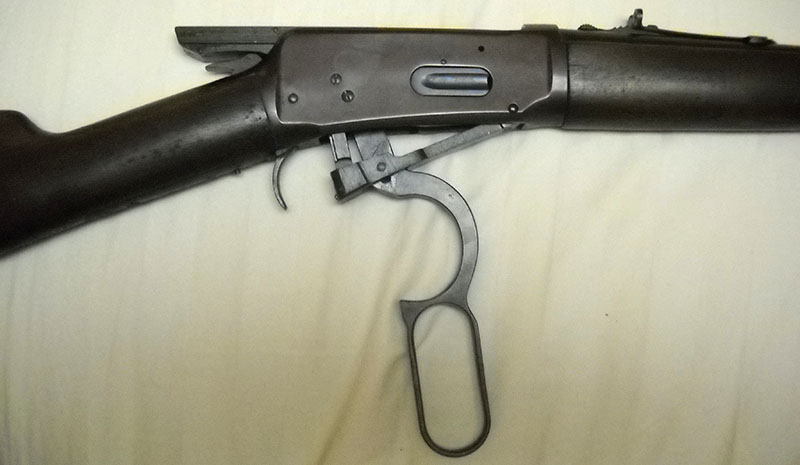
By contrast, the operative part of the Savage's lever is at the back, behind the trigger, which is instantly apparent with the action fully open.
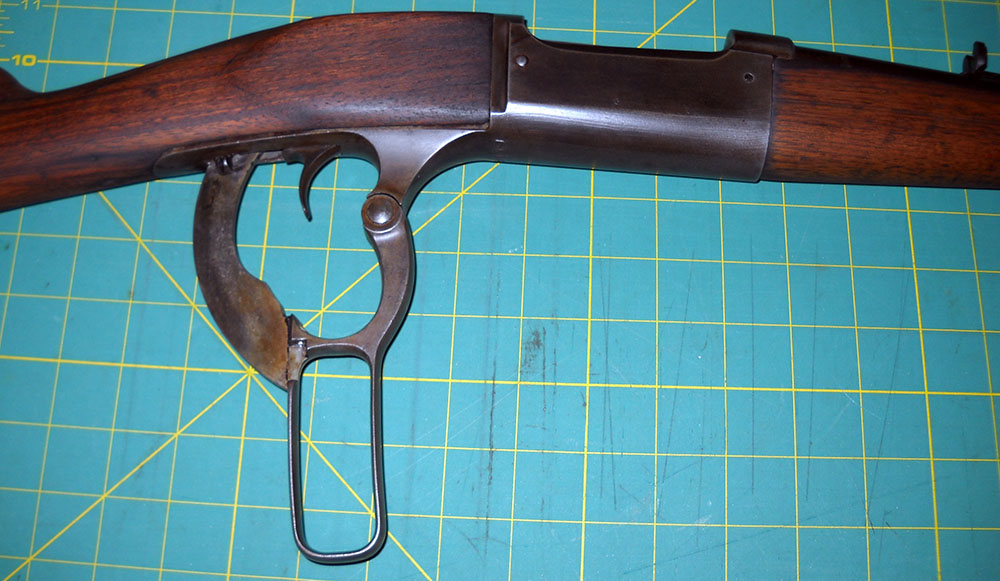
The Savage accomplishes this through the way its locking action works. Instead of a Browning-style system of locking lugs or wedges actuated by the lever, the Savage locks through the interaction of its bolt/breechblock with the receiver. With the lever fully up and the rifle locked, the bolt is raised up flush with the receiver, so that the recoil forces on the bolt are transmitted cleanly into the frame, the stock, and ultimately the shooter's shoulder.
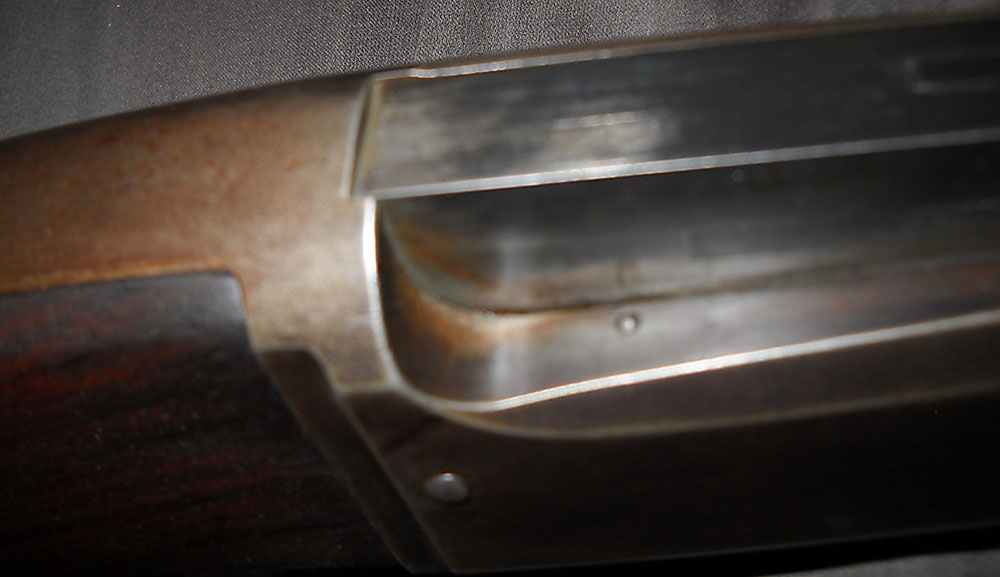
When the lever is pulled down, the first thing it does is drop the bolt out of alignment with the receiver frame.
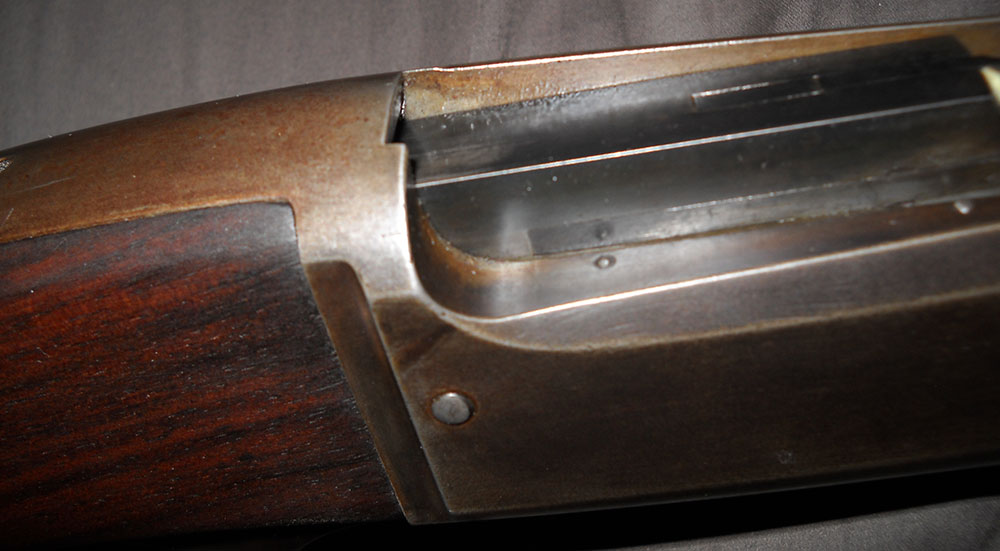
Thus dropped, it's now free to slide backward underneath the beam at the top rear of the frame and into the front of the stock, clearing the action and allowing the spent cartridge to be ejected. You'll note that the Savage doesn't have an external hammer. Unlike the Winchester, which has a bolt that slides out the back and recocks the external hammer while it's at it, everything in the Savage's action happens on the inside of the rifle. In a sense, the wood is a part of the operating system, albeit obviously not a pressure-bearing one. (Although they were marketed as "Hammerless" in contemporary catalogs, I assume there's really an internal hammer hidden in there, as in Colt's 1903 "Pocket Hammerless" pistol. However, since disassembling the Savage's action requires taking all the wood off, I've elected not to do that just yet.)
Here's a closeup of the front of the bolt near full retraction, to give you a better impression of how completely submerged in the action it is when it's fully open.
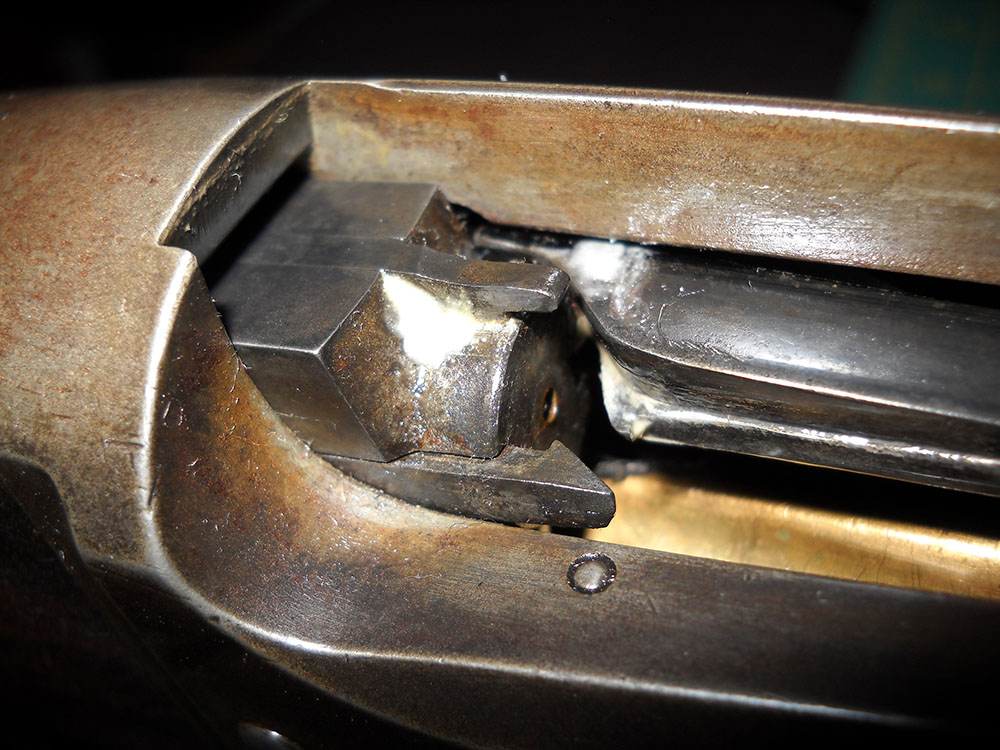
Going back a moment, notice that there's no loading gate on the side, as we find on the Winchester line. The King's Patent Loading Gate patent had expired by 1899, but the way the Savage's magazine works, it doesn't need one anyway. Looking back at the full-length photo, you'll notice that it doesn't have a tube magazine.

This has a couple of advantages. For one, it enables the rifle to have that elegant tapered forearm (known in the trade as a Schnabel forearm), which is nice if you're into that sort of thing. (John Browning seems to have been; both the Winchester 1895, the last of the Winchester leverguns and the first without a tube mag, and Browning's Remington Model 8 had them). For another, it means the Savage can be chambered for cartridges that use pointed bullets, without having to worry about recoil forces setting the whole magazine off at once.
However, the Savage doesn't have a box magazine (neither fixed nor detachable) either. Instead, it has a rotary magazine, which is interesting but hard to photograph without taking the gun apart.
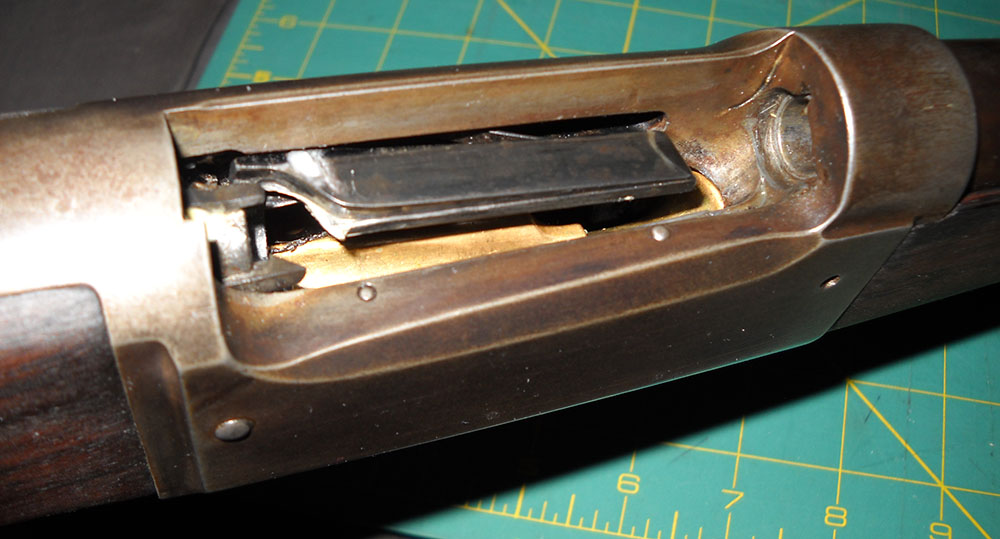
The Savage's rotary magazine is basically a set of five mechanical flanges, each designed to hold a cartridge, on a spring-loaded axis. That gold-colored piece you can see down inside the action is one of the flanges. (The big dark-grey piece is spring-loaded as well, and comes out to that position from a recess in the left side of the receiver. I don't have any compatible dummy ammunition to test it right now, but I think that bit's function is to make sure only one round at a time comes out, and possibly also to guide the new cartridge into proper alignment with the chamber.) To load the magazine, you insert a round through the top of the action and push it down until the magazine flange takes hold of it and rotates one place. The next cartridge will turn it another place, and so on, without the user actually having to rotate anything. In operation, it works the other way around, unwinding one-fifth at a time to deliver the rounds to the action in order.
This may seem needlessly complex compared with, say, a box magazine—it appears the Army thought so, which is why you don't hear about the M1895 Savage playing a role in the Spanish-American War—but it has the virtue of being reliable, easy to use once you get your head around it, and not subject to any of the Winchester 1895's magazine patents. Sure, it takes a while to load it (another thing that would have counted against it for military service), but that's not much of an issue for the sporting arm this rifle ended up being.
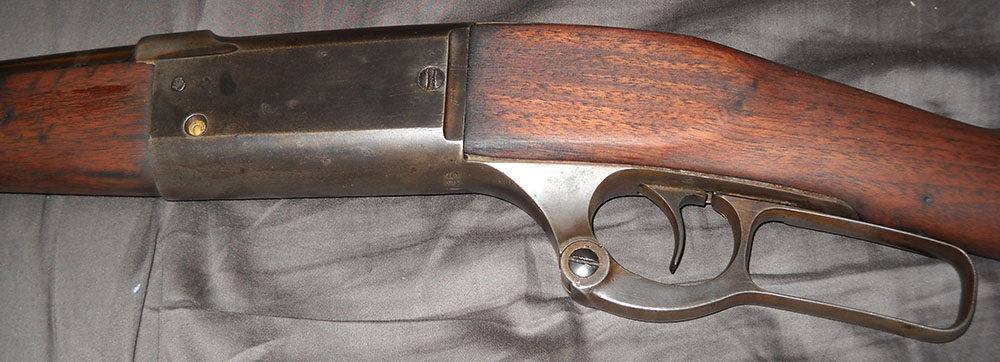
It also enables a nifty feature that very few sporting rifles—or military rifles, for that matter—have been able to boast. Over here on the left side of the action, there's not much to see—no manufacturer's logo or patent markings, just a couple of screws and—hang on, what's that little brass-looking thing?
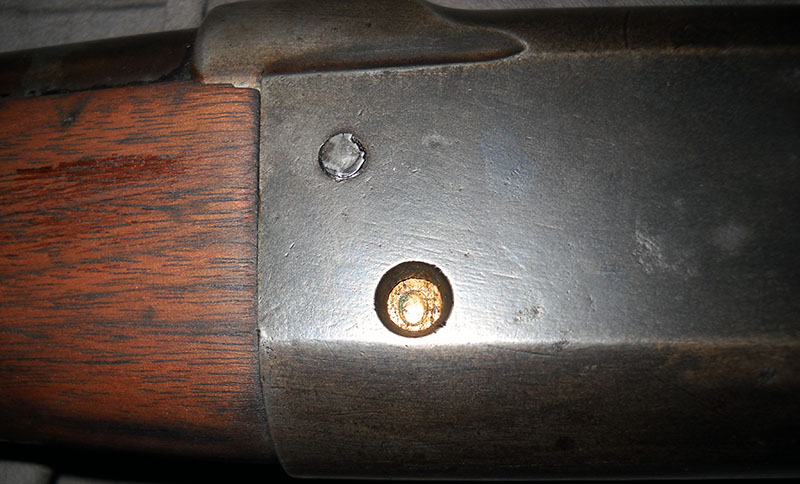
That's one of the magazine flanges, showing through a little window machined into the side of the receiver. You will note that this particular one says "0" on it, because the rifle is empty. Each one is numbered in such a way that whichever one is showing tells how many rounds are left in the magazine. Maybe that doesn't seem so impressive now, in the age of detachable box magazines with numbered witness holes, but it was a cutting-edge gadget in 1899—and unlike a detachable magazine, you don't have to unload the gun to check.
(Early semiautomatic pistol designers were also forever fooling around with cartridge counting gizmos, but they generally didn't work very well. Apart from offering a small extra potential entrance for dirt into the action, this one is pretty elegant and seems like it would be very reliable. Not a lot to go wrong with an arrangement like that.)
One feature of the Savage that is rather less successful, at least on this one, is the safety. It's this little switch located on the righthand side of the lever.
n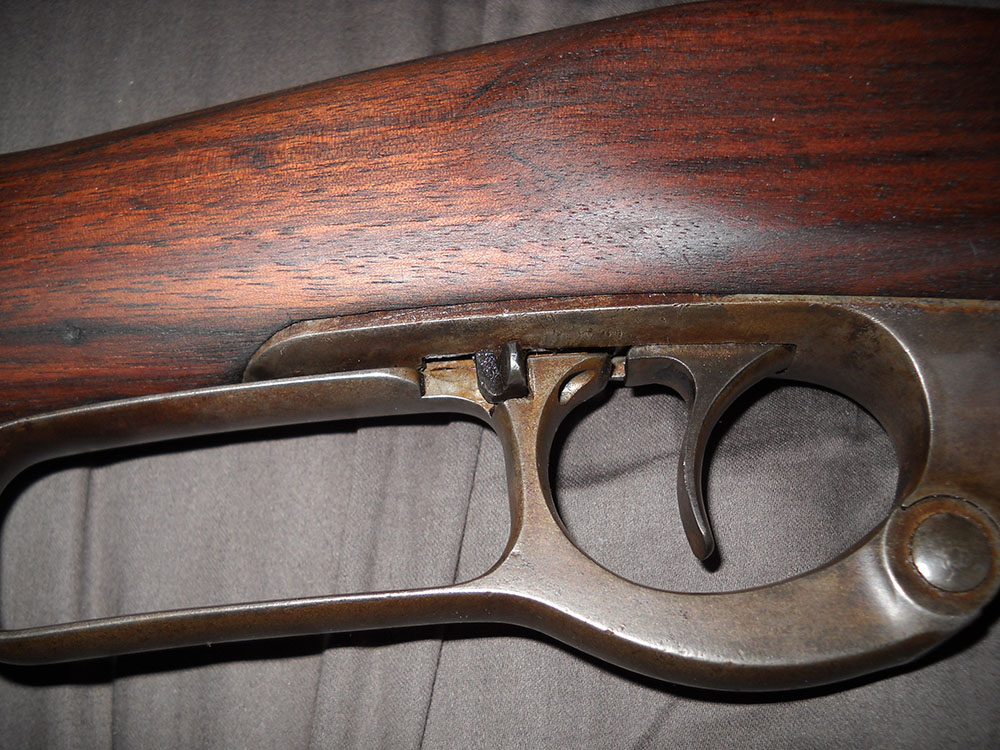
In the forward position, as seen here, this switch does two things: it locks the lever, so that the action can't be opened, and blocks the trigger, so that (in theory) the rifle can't be fired. The problem is that it doesn't seem to be very reliable. Now, it might just be that this one is worn, but it doesn't lock in either position very reliably—meaning that you can't count on it to prevent the trigger from working, but you also can't count on it not to block the lever from opening when you want it to. It's... well, it's pretty annoying. Again, though, it might just be this particular one.
Markings on this rifle are pretty sparse. In fact, when I first got it, I briefly thought it didn't have any, until I got it under better light than was available in the store (which is not poorly lit!) and found the stamping on top of the barrel that is pretty much the only mark on it, apart from the serial number (which is on the underside of the receiver).

As we see, this identifies the rifle as having been made by the Savage Arms Company of Utica, New York, USA, incorporating patents issued on two different dates in 1893 (the bits it inherited from the 1895 trials rifle) and one in 1899. It further notes that the caliber is .30 inch, which is less helpful than it might be. More on this in a moment.
A few more details: Savage Model 1899s were offered in the usual range of finish grades and with a variety of different barrel lengths. This particular one appears to be a standard-grade carbine, with a barrel of either 23 or 24 inches (depending on where you measure it from) and a slightly fancy buckhorn-style rear sight. You may have noticed a stamping on the tang of that rear sight; this is the hallmark of the sight's maker, which is not the same as the rifle's.
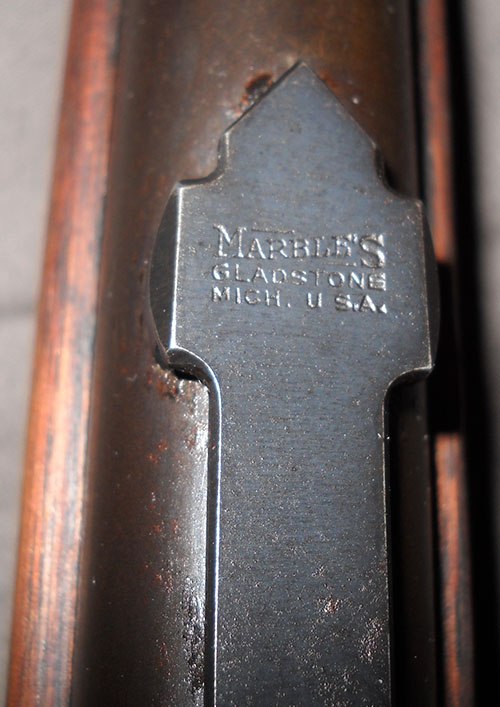
This was, and is, not at all uncommon in sporting rifles. Manufacturers will often purchase sighting systems from well-regarded vendors of such things rather than make their own in-house, and Marble's was one of the biggest names in rifle sights in the late 1800s and early 1900s. My Remington Model 8 is supposed to have a Marble's aperature sight, but some previous owner took it off to make way for a scope and evidently discarded, lost, or sold it. (I've scrounged up a new-old-stock Williams Fool Proof for it, but haven't gotten around to finding someone to put it on yet.)
Now. As to the unhelpfulness of that caliber marking. The only other mark I've found on the rifle, besides those and the serial number, is one on the barrel shank just in front of the chamber.
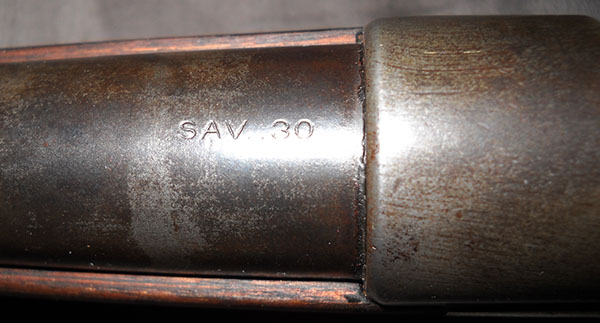
This is a bit unhelpful since, as far as I can tell, there was no such cartridge as "Savage .30". There was one called .303 Savage (not to be confused with .303 British), and Model 1899s were chambered for it, but neither here nor up on the top of the barrel is there a second "3" involved. Information on exactly what is going on here is hard to come by and doesn't always agree with other sources when you find it, but I think what is going on here is that this rifle is chambered for what was at the time called .30 Winchester Center Fire, but Savage declined to put a competitor's name on their rifle. They probably just counted on everybody In the Know being aware of what they meant. Nowadays, of course, that cartridge is called .30-30 (Winchester), for exactly that same reason, but nobody thought of that until some time well after this rifle was made. (That's what the tag it had on it in the store said, too, but you should never assume those tags are always right, especially when you're dealing with antique firearms.)
Which brings us neatly around to my favorite part of the story. The Savage Model 1899 was a popular rifle, which, like the Winchester it was designed to compete with, stayed in production for a long time. Various incarnations of the Savage company kept making them until 1998.² I guess because this one is in such good condition (despite the flash on my camera doing its usual bang-up job of making the metal parts look rusty), the dealer I bought it from assumed it was too recently made to qualify for Curio & Relic status (to remind the reader, the criteria there are basically "50+ years old or on the list"), so I had to fill out the long form and do all the usual stuff to buy it.
We didn't discuss it, but that's probably why it was so reasonably priced—because the dealer thought it was a nothing-special recent-production gun. With the subset of firearms that have been in production for so long that they exist in both collectible and recently-made forms, there's a perception in the business—often a decently justified one, it has to be said—that the newer ones aren't as good.
Anyway, when I got it home I looked its serial number up online. The sources are not 100% authoritative, I admit, and the two I found don't even quite agree with each other—but of the two, one says this rifle was made in 1900, the other in 1901. Hundreds of thousands of Savage 99s (they eventually dropped the "18", much as Winchester had) were made; this one is serial number 19 thousand and change.
I don't rightly know if that really makes it worth any more than I paid for it, but it does make it a bit more special than either the dealer or I thought it was at the time, which I think is rather nice. The wisdom among collectors is that you're buying the gun and not the story, but still, I like the thought that they have stories, even if we can never know what they are...
--G.
¹ Interestingly, the Savage & North revolver is described as having had a cylinder-advancing gas seal system, similar to that found later on the 1895 Nagant—a thing that would have been especially handy in a black-powder revolver.
² You couldn't have stuck it out for one more year and come up with a centennial edition, guys?